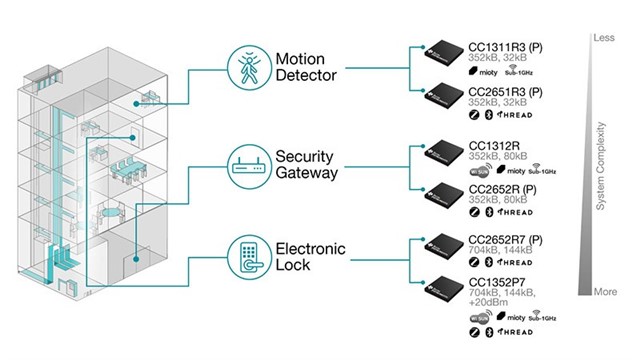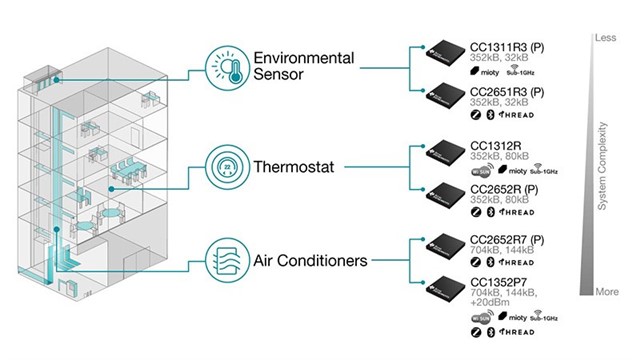SSZT157 June 2021 CC1311P3 , CC1311R3 , CC1312R , CC1312R7 , CC1352P , CC1352P7 , CC1352R , CC2640R2F , CC2640R2L , CC2651R3 , CC2652P , CC2652P7 , CC2652R , CC2652R7 , CC2652RSIP
Omdia expects low-power wireless microcontroller (MCU) shipments to double over the next four years to more than 4 billion units. This massive influx of MCUs will result in more opportunities for wireless connectivity than ever before, with growth across a wide range of applications and technologies including Bluetooth® Low Energy, Zigbee®, Thread, Matter, Sub-1 GHz, Wi-SUN and Amazon Sidewalk. With the addition of 16 new wireless connectivity devices, we are empowering you to innovate, scale and accelerate the deployment of wireless connectivity – no matter what or how you are connecting.
Designing for Wireless Connectivity
The first step in the design process is to select a wireless MCU, which means choosing both the MCU platform and radio, while also selecting one of numerous communication protocols. Not only are there several protocols to choose from, but there are a variety of features within them, each with hundreds of options, that can overwhelm you. As requirements evolve or the end products multiply, it becomes difficult to update devices and software to keep up with the wireless landscape. Therefore, it’s best to select a wireless MCU that will work for both the first and future generations of a product.
Designing with the future in mind offers the flexibility to upgrade or expand products while reusing existing investments, minimizing design cycle times and optimizing product costs. New technology capabilities like lower power, smaller size, integration and new protocol features are increasing the number of wireless applications. Products such as asset trackers, consumer wearables and long-range security systems require a varying range of features from an MCU platform.
Implementing a Multiprotocol System
Wireless connectivity designs require seamless communication between different types of end equipment. For example, in a security system for a large apartment building, several wireless devices work together to protect residents. If you were designing a full system solution with simple sensors and complex gateways, as shown in Figure 1, you’d need a range of wireless MCUs to address the various memory, power and cost requirements in your design.
 Figure 1 A Building Security System in a Large Apartment Building
Figure 1 A Building Security System in a Large Apartment BuildingThe first layer of security in the apartment building might begin with a smart e-lock for each apartment entryway. A multiprotocol e-lock uses Sub-1 GHz as the long-range communication protocol and Bluetooth Low Energy for provisioning to provide unified control and monitoring for each apartment from a central security gateway. Here, it’s important to consider memory, particularly when designing multiprotocol applications.
The SimpleLinkTM multiprotocol CC1352P7 wireless MCU is a great fit for simultaneous Sub-1 GHz and Bluetooth Low Energy protocols, with 704 kB of flash and an integrated power amplifier for increased range to cover large buildings. Future upgrades to an e-lock application could require additional memory to enable over-the-air firmware updates or features enabled with the latest protocol specifications, such as coded physical layers for Bluetooth Low Energy that increase range.
Let’s look at another application example: the heating, ventilation and air-conditioning (HVAC) system shown in Figure 2. Again, different types of end equipment need to communicate with each other. Consider taking a thermostat and enhancing it to add long-range temperature sensors into the system so that users can monitor and customize temperatures by room.
 Figure 2 An HVAC System in a Large Apartment Building
Figure 2 An HVAC System in a Large Apartment BuildingFor a thermostat gateway, SimpleLink multiprotocol CC2652P or CC1352P wireless MCUs support concurrent protocol use with a dynamic multiprotocol manager and have 352 kB of flash and 88 kB of secure random access memory to support Sub-1 GHz, Zigbee or Bluetooth Low Energy stacks. To reduce the cost of the temperature sensors, TI designed SimpleLink single-protocol CC2651R or CC1311R wireless MCUs for simplified cost-conscious applications.
Thermostat and temperature sensors have differing complexities and requirements in regards to features such as memory, size and price, which proves why choosing a wireless MCU with the right set of features at the right price is critical. It provides freedom both during the initial design process and for future innovations. The CC2562R, C2652P and CC2651P have a pre-certified system-in-package option enabling quicker time to market. In addition, software compatibility across wireless MCUs is critical to maximize investments and reuse across multiple product generations or stock-keeping units.
Saving Design Time and Investment Costs
Table 1 includes more details about the 16 new wireless MCUs (releasing throughout 2021). As you can see, you can go from a Sub-1 GHz or 2.4 GHz product with 352 kB of flash up to 704 kB of flash while maintaining the same package footprint and application programming interfaces.
| Part number | Description | Supported technologies | Flash memory | SRAM + cache memory |
|---|---|---|---|---|
| CC1312R7 | Sub-1 GHz wireless MCU | Wi-SUN Amazon Sidewalk TI 15.4 Stack Proprietary radio frequency (RF) | 704 kB | 152 kB |
| CC1352P7 | Multiprotocol and multiband wireless MCU with an integrated power amplifier | Wi-SUN Amazon Sidewalk Zigbee Thread Bluetooth Low Energy 5.2 TI 15.4 Stack Proprietary RF | 704 kB | 152 kB |
| CC2652R7 | Higher memory, multiprotocol wireless MCU | Matter Bluetooth Low Energy 5.2 Bluetooth Mesh Zigbee 3.0 Thread Proprietary 15.4 | 704 kB | 152 kB |
| CC2652P7 | Higher memory, multiprotocol wireless MCU with an integrated power amplifier | Matter Bluetooth Low Energy 5.2 Bluetooth Mesh Zigbee 3.0 Thread Proprietary 15.4 | 704 kB | 152 kB |
| CC2672R3 | Multiprotocol and multiband wireless MCU | Zigbee Sub-GHz Bluetooth Low Energy 5.2 | 352 kB | 88 kB |
| CC2672P3 | Multiprotocol and multiband wireless MCU with an integrated power amplifier | Zigbee Sub-GHz Bluetooth Low Energy 5.2 | 352 kB | 88 kB |
| CC2652RSIP | 7-mm-by-7-mm system-in-package wireless module | Bluetooth Low Energy 5.2 Bluetooth Mesh Zigbee 3.0 Thread Proprietary 15.4 | 352 kB | 88 kB |
| CC2652PSIP | System-in-package module with integrated power amplifier | Bluetooth Low Energy 5.2 Bluetooth Mesh Zigbee 3.0 Thread Proprietary 15.4 | 352 kB | 88 kB |
| CC1311R3 | 7-mm-by-7-mm low-cost, single-protocol Sub-1 GHz wireless MCU | Mioty TI 15.4 Stack Proprietary RF | 352 kB | 40 kB |
| CC1311R3 | 5-mm-by-5-mm low-cost, single-protocol Sub-1 GHz wireless MCU in a smaller package with 22 general-purpose input/outputs | Mioty TI 15.4 Stack Proprietary RF | 352 kB | 40 kB |
| CC1311P3 | Low-cost, single-protocol Sub-1 GHz wireless MCU with an integrated power amplifier | Mioty TI 15.4 Stack Proprietary RF | 352 kB | 40 kB |
| CC2651R3 | 7-mm-by-7-mm low-cost, single-protocol wireless MCU | Bluetooth Low Energy 5.2 Bluetooth Mesh Zigbee 3.0 Thread Proprietary 15.4 | 352 kB | 40 kB |
| CC2651R3 | 5-mm-by-5-mm low-cost, single-protocol wireless MCU | Bluetooth Low Energy 5.2 Bluetooth Mesh Zigbee 3.0 Thread Proprietary 15.4 | 352 kB | 40 kB |
| CC2651P3 | 7-mm-by-7-mm low-cost single-protocol wireless MCU with an integrated power amplifier | Bluetooth Low Energy 5.2 Bluetooth Mesh Zigbee 3.0 Thread Proprietary 15.4 | 352 kB | 40 kB |
| CC2651P3 | 5-mm-by-5-mm low-cost single-protocol wireless MCU with an integrated power amplifier | Bluetooth Low Energy 5.2 Bluetooth Mesh Zigbee 3.0 Thread Proprietary 15.4 | 352 kB | 40 kB |
| CC2651R3SIPA | System-in-package module with integrated antenna | Bluetooth Low Energy 5.2 Bluetooth Mesh Zigbee 3.0 Thread Proprietary 15.4 | 352 kB | 40 kB |
When selecting your wireless MCU, you are not only choosing the platform and radio for your current design but also preparing for future designs. With the addition of 16 new wireless connectivity devices, our expansive portfolio covers cutting-edge technologies with intuitive development tools and software, enabling you to connect any device with the right features and at the right price.
Whenever you are designing for the ever-changing world of wireless connectivity, it is essential to have freedom and flexibility. The question remains: Are you prepared to evolve with our connected world, or will you be left behind?